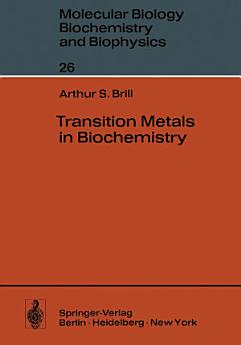Transition Metals in Biochemistry
A. S. Brill
ธ.ค. 2012 · Molecular Biology, Biochemistry and Biophysics Molekularbiologie, Biochemie und Biophysik หนังสือเล่มที่ 26 · Springer Science & Business Media
eBook
186
หน้า
reportคะแนนและรีวิวไม่ได้รับการตรวจสอบยืนยัน ดูข้อมูลเพิ่มเติม
เกี่ยวกับ eBook เล่มนี้
Transition metal ions in biological systems are of interest in biology, biochemistry, chemistry, medicine, and physics. Scien tists with rather different viewpoints, employing many methods, have contributed to this area. A concise review of the current state of the field will, to some extent, reflect the special knowledge of the person writing it - in this case application of physical methods to the investigation of metal coordination. x ray diffraction is one of the most important of these methods, but a useful treatment of X-ray structure analysis would be com parable in size with and beyond the scope of the monograph. Many results of X-ray diffraction studies are, of course, presented. Electron paramagnetic resonance spectroscopy has played a major part in the rapid advance in knowledge of the electronic struc tures of transition metal ions in biological systems. More gener ally, measurements involving light, microwaves, and magnetic fields are capable of producing much new information, and the required instrumentation is available at most research institu tions. Therefore light absorption and paramagnetic resonance are treated in depth. The principles described in the latter discus sions are broadly applicable, for example to the promising tech niques of X-ray spectroscopy (utilizing synchrotron radiation) and lanthanide-perturbed, very high-resolution nuclear magnetic resonance spectroscopy.
ให้คะแนน eBook นี้
แสดงความเห็นของคุณให้เรารับรู้
ข้อมูลในการอ่าน
สมาร์ทโฟนและแท็บเล็ต
ติดตั้งแอป Google Play Books สำหรับ Android และ iPad/iPhone แอปจะซิงค์โดยอัตโนมัติกับบัญชีของคุณ และช่วยให้คุณอ่านแบบออนไลน์หรือออฟไลน์ได้ทุกที่
แล็ปท็อปและคอมพิวเตอร์
คุณฟังหนังสือเสียงที่ซื้อจาก Google Play โดยใช้เว็บเบราว์เซอร์ในคอมพิวเตอร์ได้
eReader และอุปกรณ์อื่นๆ
หากต้องการอ่านบนอุปกรณ์ e-ink เช่น Kobo eReader คุณจะต้องดาวน์โหลดและโอนไฟล์ไปยังอุปกรณ์ของคุณ โปรดทำตามวิธีการอย่างละเอียดในศูนย์ช่วยเหลือเพื่อโอนไฟล์ไปยัง eReader ที่รองรับ







